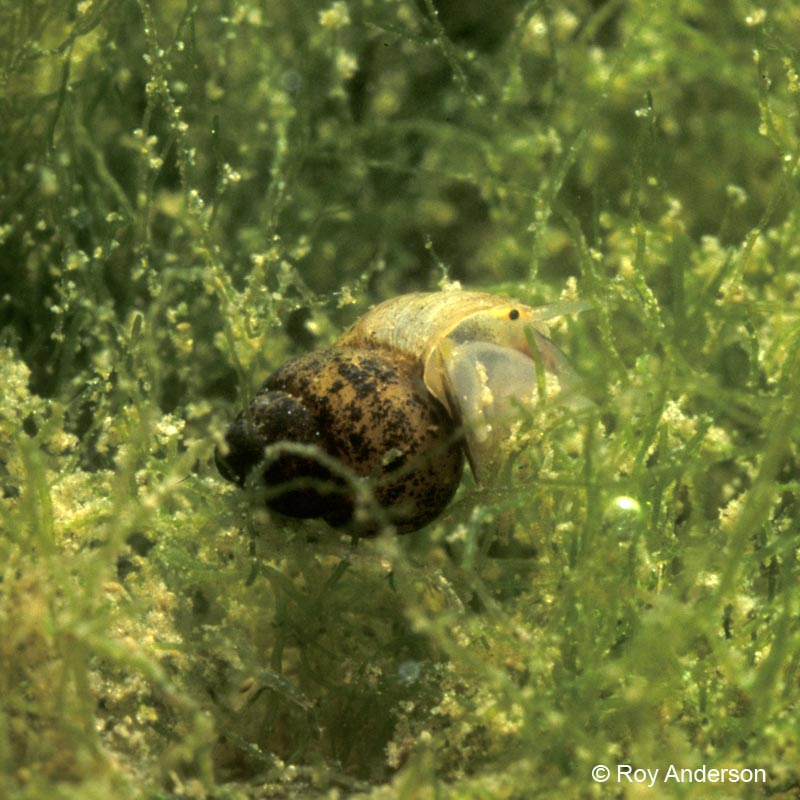| Mollusca : Gastropoda : Littorinimorpha : Hydrobiidae | Snails and slugs |
Mercuria tachoensis (Frauenfeld, 1865)
Swollen spire snail
 |
| Mercuria tachoensis |
Description: A hydobiid mud snail, small, operculate but relatively low-spired, with a large body whorl compared to other species. Shell fragile, translucent yellow-white but often coated with dark deposits and animal entirely pale. Rare, usually in the upper part of the tidal range in estuaries and in fresher water than Assiminea. 3-4 mm.
World Distribution: Ranges along coasts from southern and western Ireland and south-eastern Britain to the western Mediterranean. Distribution type Suboceanic Southern Temperate (82).
Irish Distribution: Known since the nineteenth century from Waterford Harbour (Rivers Suir, Nore and Barrow) and the Shannon Estuary (Stelfox, 1911). Its distribution in Britain is centred on the Thames Estuary and the south-east coast where it appears to be in decline due to disturbance or pollution of its preferred habitat (Kerney, 1999). In Ireland there appears to be little change with the species still fairly common in its Shannon Estuary sites on the R. Maigue, Limerick, R. Fergus, Clare and Shannon contributaries near Limerick (Colville, 1992; R. Anderson, pers. obs.) and at least some of the sites in Waterford Harbour, including the Blackwater contributary to the Nore and sites on the Barrow at Ballnabola and Mount Garrett Bridge (pers. comm. of D. Holyoak)
Ecology:
- In Britain Mercuria associates with freshwater species such as Potamopyrgus antipodarum, Bithynia tentaculata or with lymnaeids and planorbids in nearly fresh conditions (Fretter & Graham, 1978)
- At the Shannon sites it is found on glutinous calcareous mud on the margins of tidal streams with a mixture of freshwater species including Galba truncatula, Lymnaea fuscus, Potamopyrgus antipodarum and the amphibious species Oxyloma elegans and Deroceras laeve
Key Identification Features:
- A small, hydrobiid snail with a proportionately larger body whorl than other hydrobiids
- Shell dull, yellow-white but often coated with a darker deposit
- Animal uniformly pale and tentacles pale
Taxonomy:
- The correct name for this taxon is by no means certain. There is little doubt that Mercuria confusa (Frauenfeld) is closely related to Mercuria similis (Draparnaud 1805), a common Mediterranean freshwater species. Giusti (1979) and Giusti et al. (1995) argue that the numerous 'species' of Mercuria claimed for Mediterranean habitats are at best geographical subspecies, at worst merely demes, of one variable taxon. Their inference extends to the Atlantic/west Mediterranean form confusa which may well turn out to be synonymous with similis and consequently to have a Mediterranean-Atlantic distribution like the hydrobiids Hydrobia acuta and Ventrosia ventrosa. If the Atlantic and Mediterranean forms are synonymous then similis (Draparnaud 1805) has page priority over anatina (a name applied to British populations by Bank et al. (2007)) in Draparnaud's monograph.
Red list status:
- Endangered (EN).
Distribution Map from NBN: Mercuria tachoensis at National Biodiversity Network mapping facility, data for UK.
iNaturalist: Mercuria tachoensis at iNaturalist World Species Observations database.
GBIF data for Mercuria tachoensis | Classification: Gastropoda, Littorinimorpha, Hydrobiidae, Mercuria
Thumbnails for genus Mercuria
| Anderson, R., 2025. Mercuria tachoensis. (Frauenfeld, 1865). [In] MolluscIreland. https://www2.habitas.org.uk/molluscireland/species.php?item=116. Accessed on 2025-04-02. |
